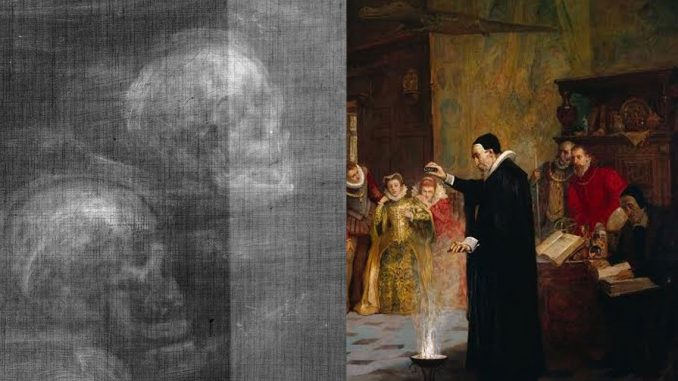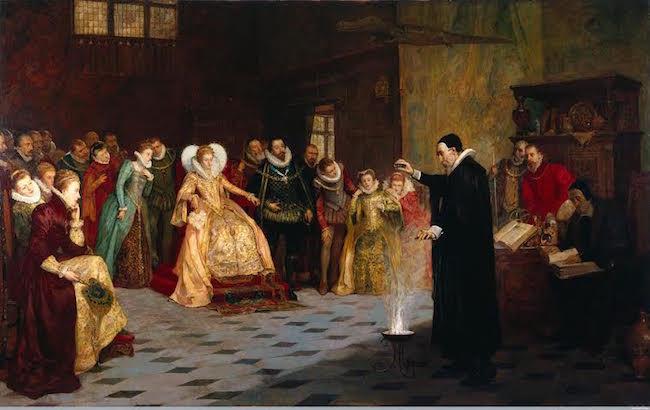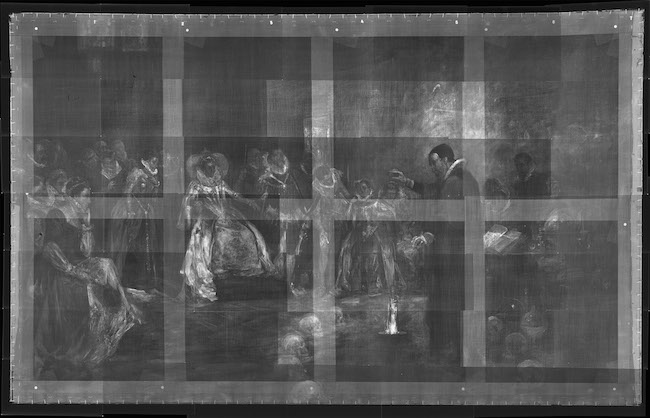
New X-ray imaging has revealed that a ring of secret skulls originally encircled a depiction of the 16-century English mathematician, astronomer, astrologer, occult philosopher, imperialist, and adviser to Queen Elizabeth I John Dee – by artist Henry Gillard Glindoni.
Glindoni had been forced to censor the image when he created it in the 19th-century, disguising the rich occult symbology in order to transform it into a more scientific depiction.

BYPASS THE CENSORS
Sign up to get unfiltered news delivered straight to your inbox.
You can unsubscribe any time. By subscribing you agree to our Terms of Use
Latest Video
Hyperallergic.com reports:
The discovery was made in research for Scholar, Courtier, Magician: The Lost Library of John Dee, opened this week at the Royal College of Physicians (RCP) in London. In our previous coverage of the exhibition, curator Katie Birkwood explained that in Tudor England, “the distinctions between magic and natural philosophy — as the subject we now think of science would have been termed then — were not nearly so clear-cut” as they are today.
The alteration of the painting, from a vivid black magic ritual to a scene more suggestive of a scientific demonstration, likewise represents the tension in Dee’s identity between being a man of science and one of the occult.
As in Joseph Wright of Derby’s“The Alchemist Discovering Phosphorus” (1771), where the bright light of the chemical reaction of phosphorus is framed as a supernatural act, the division between the two is blurred in Glindoni’s painting.


In The Lost Library of John Dee, the painting is installed near a portrait of 17th-century physician Sir Theodore de Mayerne, who sports a skullcap, long beard, and robe as he cradles a human cranium in one hand.
The juxtaposition with the Glindoni painting shows similarities between the two men — the garb of a magician could just as easily be that of a scholar — and demonstrates that skulls could indicate anatomical knowledge, a memento mori, or the dark arts.
“It is therefore the Victorians who had a problem with the skulls rather than any previous age,” Discover Medical London‘s Berwyn Kinsey told Hyperallergic, noting that Tudor art often featured skulls with no magical association, such as Hans Holbein the Younger’s “The Ambassadors” (1533), in which an anamorphic skull appears only from a certain angle.
The X-ray found other alterations to the Glindoni painting, including the addition of Dee’s assistant medium Edward Kelley, wearing a cap that hid his cropped ears (likely a punishment for a crime like forgery, according to RCP), as well as jars and other spherical objects in front of the table near Dee.
Queen Elizabeth I visited Dee at his Mortlake home on four known occasions; this scene was painted centuries later and was heavily influenced by its Victorian present, as well as by the patron who likely commissioned the large-scale work from Glindoni.
Alterations to paintings are not uncommon, including efforts to change the meaning. For example, Gustave Courbet’s “L’Homme blessé” (The Wounded Man, 1844–45) originally showed a man and a woman reclining serenely together, but at the fractured end of a relationship Courbet substituted her body with a sword, dousing the man’s shirt with blood.
Raphael’s “Portrait of a Lady with a Unicorn” (1503–06) was painted over more than once: the first time, its original dog was replaced with a unicorn to change the symbolism from loyalty to purity; in the 17th century, St. Catherine’s spiked wheel was added over the unicorn, and a cover over the lady’s shoulders, making her into a saint. The skulls in the John Dee painting reveal as much about Victorian sensibilities as they do about the Tudor magician, showing an unease with the occult legacy of the “Queen’s Conjuror.”


